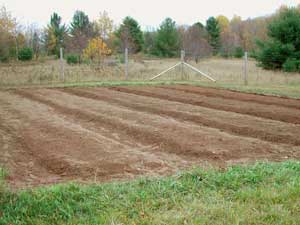My initial idea was to bulldoze up 4 foot wide swaths of the soil to sift out the rocks then drop it back into the hole....followed by taking up the adjacent 3 feet of soil, sifting the rocks, the pouring it on top of the raid bed area.
If ai do that on both sides of the raised bed (topping the bed with soil from each sode...I can get the raised bed up to about 5-6 feet of soil above the caliche layer.
Keep in mind that above that caliche, you may still have two layers, a top soil and a subsoil and you don't want to mix those together. I don't think any veggies really require 5-6 foot. Even tomatoes should be fine with 2 feet or even 1 foot.
Mel of Square Foot Gardening used to dig up 6 inches of top soil and mix 6 inches worth of compost in to give him 1 foot of good soil and his raised beds were 6 inches tall to hold that 6 inches of compost added. In the second edition of his book, he changed to just using the 6 inches of compost without disturbing the top soil. I like his first method better.
According to wikipedia article quoted above, the top soil may be "basic" (reference - Managing Caliche in the Home Yard UofAZ - https://repository.arizona.edu/bitstream/handle/10150/144769/az1281-2002.pdf?sequence=1&isAllowed=y
What grows in your yard or on your property now? Grass, weeds, shrubs, trees, nothing? If there's stuff growing, I wouldn't worry too much about that "basic" thing but you might want to get a soil test to make sure it's not way out of whack.
I would go for 1-2 feet deep loosened soil and permanent raised beds as tall as you can get them, maybe 6-8 inches tall. Can't find a good pic but something in between these two examples.


Have the low spots wide enough to use as walkways, 45 degree slope on edges of beds because anything steeper will just fall apart. Beds as wide as you like and add all the compost you can afford to the bed areas. Most market gardeners are doing 30 inch beds and there's a lot of tools and equipment sized for 30 inch and the beds can be straddled by most people. I don't know what your drainage is like and don't know how hard packed the soil is above the caliche. You could just till it and then form beds. With a good sized tractor, you could run a single tine chisel plow every foot or two, then till, then form beds.
Depending on how big it will be, you could double dig it. I've done that a couple of times. Dig off top soil to the depth of a shovel and set aside. Stick a fork down in where you dug and rock back and forth to crack the lower soil, fill back in. If you look up double digging, there's a madness to the method. That first dig is brought to the other side of the garden. Second dig fills the first dig after the first has been cracked with fork. Then you crack the second dig, dig third and dump into second, crack third etc etc. That last dig dirt is tossed into second to last, last is cracked and the first soil you dug and brought to the other side of garden is right there to dump in that last dig.
We have hard pan here in Missouri and it's a little like concrete. Grey, dead, gravel mixed in. I hand dug all my fence post holes and some took most of a day of slamming a chipping bar down in the hole to break the stuff up, take a scoop with digger, repeat. I've seen a 1 inch hole in my garden area out back that bubbled up water for over a week after we had days of rain. Had no place to go but up I guess. I've done raised beds with sides using various things. Wood works well but rots quick around here. Everything else like rocks or blocks take up space and you end up kneeling on them which hurts the knees. I just do like the pic above on the right anymore. One of these days I'll make a bed former for my little tractor.